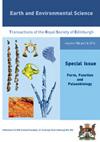基于钻孔的捕食-捕食相互作用——以台湾更新世塞口组turritelline腹足类为例
IF 1.2
4区 地球科学
Q4 GEOSCIENCES, MULTIDISCIPLINARY
Earth and Environmental Science Transactions of the Royal Society of Edinburgh
Pub Date : 2023-09-08
DOI:10.1017/s1755691023000130
引用次数: 1
摘要
贝壳上的钻孔为调查猎物和捕食者的关系提供了一种有用的方法。目前的研究记录了台湾恒春半岛更新世Szekou组腹足类Turritella cingulifera化石的动物群,即食肉动物与猎物的相互作用。收集并记录了所有尺寸大于3毫米的可识别骨骼和外壳碎片。经处理的散装沉积物(5.24公斤)含有1462个软体动物外壳,其中包括824个扣带T.cingulifera标本和27个非软体无脊椎动物。在目前的研究中,大约41.6%(609/1462)的软体动物至少钻了一个洞。在所有腹足类、双壳类和turritelline腹足类T.cingulifera中,无论外壳完整性如何,钻孔强度(DI)分别为0.546、0.060和0.413。turritellids的DI显著低于其他腹足类(χ2=21.039,P<0.001)。此外,基于完全到几乎完全标本的turritelline腹足类在多次钻孔标本中出现的钻孔百分比为34.7%(95/275)(n=588)。我们的研究表明,无论是在缝合线上还是在螺纹上,钻孔位置都没有显著的偏好(χ2=0.055,P=0.814)。大多数钻孔位于孔径附近的两到四个螺纹中。有一个钻孔和有多个钻孔的壳的钻孔直径平均为1.0和0.5 mm,Mann–Whitney试验结果表明它们有显著差异(P<0.001)。根据钻孔形态和同一组合中存在的naticids,主要的钻孔捕食者是naticids。没有观察到明显的猎物大小选择性,因此在当前的研究中不存在turritellids的“大小避难所”。本文章由计算机程序翻译,如有差异,请以英文原文为准。
Predator–prey interactions based on drillholes: A case study of turritelline gastropods from the Pleistocene Szekou Formation of Taiwan
Drillholes on shells provide a useful way to investigate prey and predator relationships. The current study documents predator–prey interactions exemplified by a faunal assemblage of the fossil gastropod Turritella cingulifera from the Pleistocene Szekou Formation in Hengchun Peninsula, Taiwan. All recognisable skeletal and shell fragments that are larger than 3 mm in size were collected and recorded. Processed bulk sediments (5.24 kg) contained 1462 molluscan shells, including 824 specimens of T. cingulifera, and 27 non-molluscan invertebrates. In the current study, approximately 41.6% (609/1462) of molluscs are drilled with at least one hole. Drilling intensities (DIs) regardless of shell completeness in all gastropods, bivalves and the turritelline gastropod T. cingulifera are 0.546, 0.060 and 0.413, respectively. DI on turritellids is significantly lower than that on other gastropods (χ2= 21.039, P < 0.001). Furthermore, the percentage of drillholes that occur in multiply drilled specimens is 34.7% (95/275) for turritelline gastropods based on complete to nearly complete specimens (n = 588). Our study shows no significant preference of drillhole position either on the suture or on the whorl (χ2= 0.055, P = 0.814). Most drillholes are located in whorls two to four proximal to the aperture. Drillhole diameters of the shells with one drillhole and ones with multiple drillholes are 1.0 and 0.5 mm on average, and the results of Mann–Whitney tests indicate that they are significantly different (P < 0.001). The first turritelline gastropod shell with an incomplete drillhole from Taiwan is documented here. The dominant drilling predators were naticids based on the drillhole morphology and the presence of naticids in the same assemblage. No apparent prey size selectivity is observed, so a ‘size refugium’ does not exist for the turritellids in the current study.
求助全文
通过发布文献求助,成功后即可免费获取论文全文。
去求助
来源期刊
CiteScore
2.00
自引率
0.00%
发文量
21
期刊介绍:
Earth and Environmental Science Transactions (formerly Transactions of the Royal Society of Edinburgh: Earth Sciences) is a general earth sciences journal publishing a comprehensive selection of substantial peer-reviewed research papers, reviews and short communications of international standard across the broad spectrum of the Earth and its surface environments. The journal prides itself on the quality of its graphics and photographic reproduction. The Editors are keen to encourage interdisciplinary papers and Transactions also publishes occasional special symposia and invited volumes of specific interest.
We are currently in the process of digitising the archive of RSE Publications, and the archive of the Transactions, dating back to 1788, will be available from the back issues link on this site.

 求助内容:
求助内容: 应助结果提醒方式:
应助结果提醒方式:


